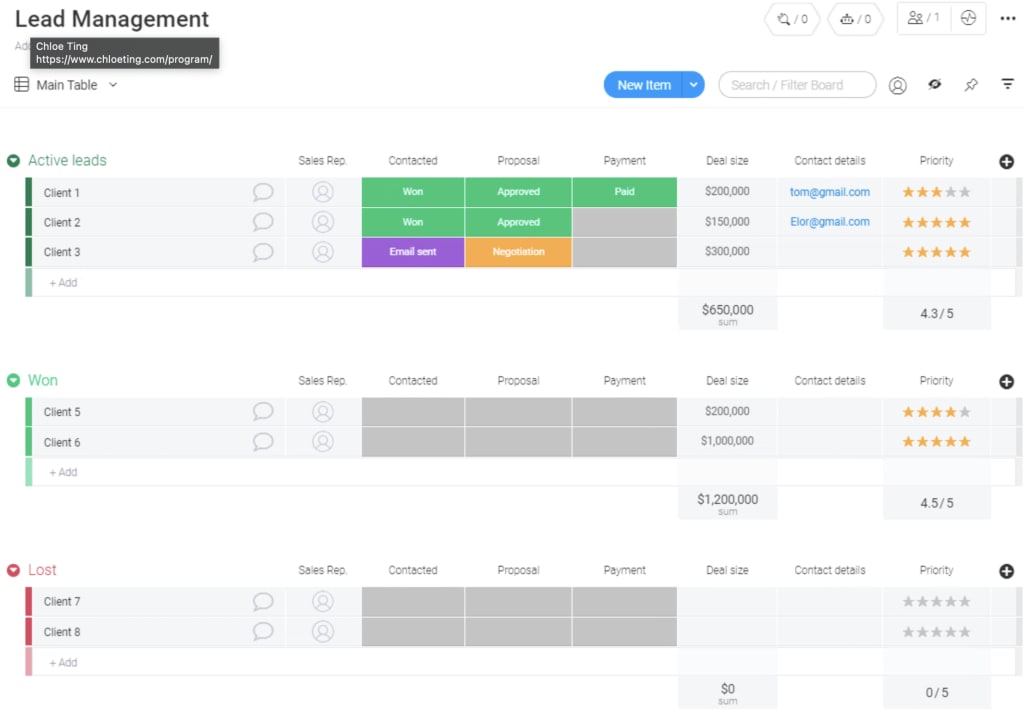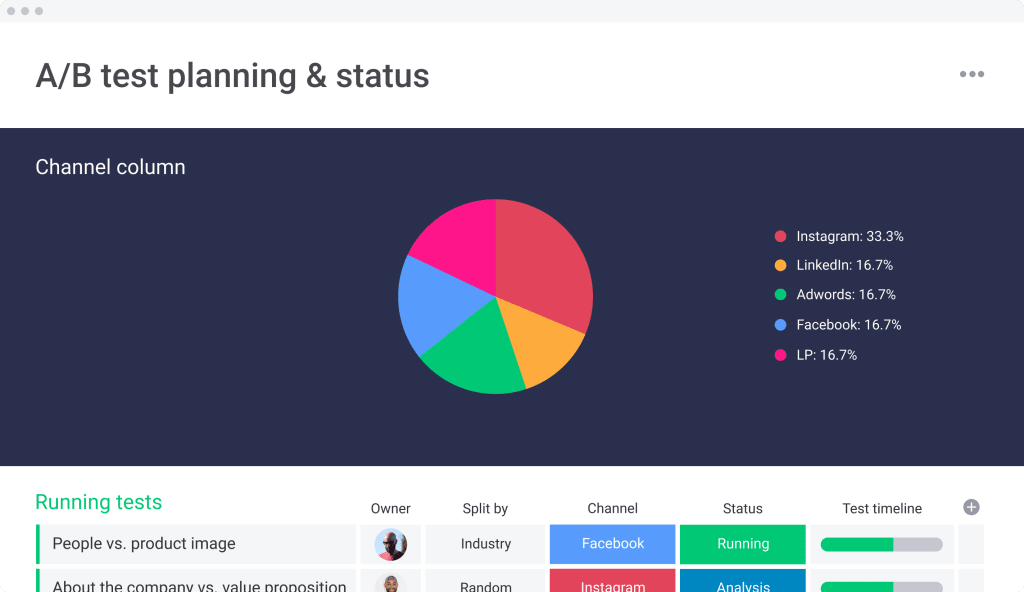You may have mastered getting traffic to your site, but what good is that traffic if visitors aren’t converting?
Depending on who you ask, you’ll probably get a different answer on how to optimize your conversion rate. That’s not to say one answer is more or less correct than another, just that there are tons of different strategies out there that can work for a business, but that doesn’t mean that all of them will be right for your business.
In this post, we’ll explore different conversion rate optimization strategies and show you how a work OS like monday.com can help you keep your new strategies organized.
What is conversion rate optimization?
Conversion rate optimization (CRO) is the process of optimizing a website or landing page to increase the percentage of visitors who take a desired action. The action depends on the industry or the business, and can be anything like:
- Completing a purchase
- Signing up for a newsletter
- Getting a quote
- Starting a free trial
- Scheduling a demo
Optimizing a conversion rate is typically achieved through a combination of tactics, such as improving a website’s design, content, or user experience. The goal of CRO is to understand why visitors aren’t taking the desired action in order to make relevant changes.
How can you measure conversion rate optimization?
The most common way to measure conversion rate optimization is to calculate the percentage of visitors to a website who convert. The formula looks like this:
Conversion rate = conversions/visitors x 100
For example, if 100 people visit a website and 10 of them make a purchase, the conversion rate would be 10%.
Calculating your conversion rate is the first step towards optimizing it. That said, there’s no overall “good” conversion rate, rather the exact rate your business should strive for depends highly on your industry. The average conversion rate for eCommerce companies was 2.3% in 2022. However, for food and beverages, the conversion rate benchmark was at 9.8% in 2021, the highest of any industry.
Conversion rate optimization strategies: which one is right for you?
When working on your conversion rate, it’s essential to understand your customer first.
By knowing what your customers want, what matters to them, and what problems they’re looking to solve, you’ll already have a better idea of where to begin optimizing your conversion rate.
Once you’ve taken the time to understand your customers’ needs, here are a few different CRO strategies you can try out.
1. A/B testing
A/B testing is a method of testing used to compare two versions of a web page, app, feature, or other digital product to determine which one performs better. By conducting A/B tests, companies can optimize their website or design to improve the conversion rate.

There are many things companies can A/B test, such as the color of a CTA button, placement of a lead capture form, or even the wording on a landing page. A/B testing can help improve conversion rate by enabling brands to make informed decisions about design and messaging that resonates most with their target audience.
2. Optimizing site navigation
Optimizing site navigation can help improve conversion rates by making it easier for visitors to find what they’re looking for. By making navigation more intuitive, visitors can quickly and easily access the right content. When users spend time searching, they’re not finding what they’re looking for and are more likely to leave your website. Additionally, having a website that’s easy to navigate can help create a more positive user experience, leading to increased customer satisfaction, engagement, and eventually conversion.
3. Focus on creating engaging content
Creating engaging content can have a positive impact on conversion rate by providing value to potential customers. Engaging content is any type of content that captures attention, is informative, entertaining, relevant, and encourages viewers to take action. This can include blog posts, videos, webinars, podcasts, infographics, and interactive content. Whatever type of content you choose to create, to improve conversion rate, make sure that:
- Content is optimized for mobile devices
- There are clear CTAs in the content
- The content answers a user’s query
- It’s optimized for search engines (SEO)
4. Invest in the right tools
Just because optimizing your conversion rate is individual to each company and industry doesn’t mean you’re completely on your own! There are plenty of tools meant to help you understand and improve your conversion rate. Some of these tools include:
- Workflow management tools like monday.com to organize CRO initiatives
- Web analytics tools such as Google Analytics to help you see metrics
- Heatmaps such as HotJar to see how users interact with a page
- Survey tools such as SurveyMonkey to better understand customers
- Landing page builders like Instapage to create optimized campaign pages
5. Create a variety of CTAs
When optimizing CTAs, you shouldn’t just crowd a webpage with buttons. Instead, use a variety of CTA types tailored to each page. For example, a blog might have in-text CTAs as well as CTA banners or buttons interspersed within the text. Some other types of CTAs you might want to consider include:
- CTAs that come in as a slide-up, drop-down, or pop-up to see what works best
- Single text box sign-up forms
- Longer lead capture forms
- Sharing buttons
Using monday.com to build a CRO strategy
With so many strategies to try, it can be confusing to keep track of your CRO progress. Different teams might be working on different projects: design might be updating a webpage, while the content department is working on creating engaging blog posts. It’s important that businesses keep track of their optimization efforts so that nothing falls through the cracks. That’s where monday.com comes in.
Manage leads

Manage your leads with a monday.com board, allowing your teams to manage leads as they come in to understand where the conversion process is working in order to create more similar opportunities.
Plan A/B tests

With A/B testing templates, you can keep everyone up to speed on the current tests you’re running, create collaborative workflows, and import and analyze the results of your test.
Collaborate on design updates

Schedule and plan out the designs you need to optimize your webpages so that your design team can collaborate and brainstorm ideas in an organized way.
FAQs
How can you improve conversion rate optimization?
Using the methods above, try and implement new strategies and see what works best. In general, using a mix of strategies, such as A/B testing, creating engaging content, and optimizing the user experience will all improve your CRO in different ways.
Why is conversion rate optimization important?
CRO helps businesses better understand their customers and is essential for improving website performance. It helps to identify areas of improvement and opportunities to increase the number of visitors that become customers.
What can help you analyze conversion rate optimization?
There are different tools businesses can use to analyze and measure CRO. Google Analytics is a good place to start as you’ll get your conversion rate along with other metrics. Other tools like heatmaps and surveys can also help you understand and analyze your current user experience.
The best CRO strategy is to just get started
No matter which method you choose to improve your conversion rate, it’s important to just start somewhere. The more you wait, the more leads and potential customers are getting away. While you’re trying out different strategies to see which one works best, a tool like monday.com will help you keep everything streamlined and allow different departments to collaborate efficiently.

